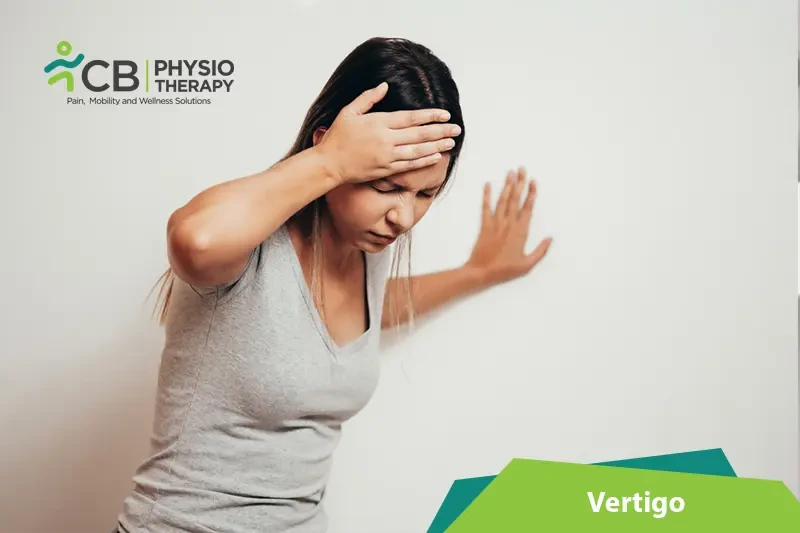
Vertigo is a type of dizziness in which the patient experiences the perception of motion (usually a spinning motion) due to dysfunction of the vestibular system. The vestibular system is the sensory system that provides the sense of balance and orientation to coordinate movement with balance.
Types of vertigo:
Depending on the location of dysfunction of the vestibular pathway, vertigo is classified into peripheral or central.
Peripheral: Vertigo is caused due to problems in the inner ear or vestibular system, which is composed of semicircular canals, the vestibule, and the vestibular nerve.
Central: Vertigo that occurs from injury to the balance centers of the central nervous system (CNS), caused by a lesion i.e wound or injury in the brainstem or cerebellum. It is usually associated with less prominent movement illusion and nausea.
Symptoms vary from person to person depending on the actual cause of vertigo. Some of the symptoms are listed below:
Pathology
Vertigo is a symptom and a type of dizziness. It arises because of asymmetry in the vestibular system due to damage or dysfunction of the labyrinth, central vestibular structures in the brainstem, or vestibular nerve.
Inner ear complications are the most common causes of vertigo, some other contributors are:
Benign Paroxysmal Positional Vertigo (BPPV) also known as "loose crystals", is the most common type of vertigo. BPPV occurs due to small crystals of calcium that loosen in the inner ear and travel into the semicircular canals, disturbing the fluid and creating the sensation of movement.
Tests for vertigo are done to elicit nystagmus and to differentiate vertigo from other causes of dizziness such as hyperventilation syndrome, presyncope, disequilibrium, or psychiatric causes of lightheadedness.
Medical History:
To diagnose vertigo, medical history is taken from the patient, including details about the symptoms. The patient may be asked what the sensation of movement or dizziness is felt, how frequently it occurs, whether it occurs while moving in a particular way, certain times of the day, and whether hearing loss or ringing in the ears is also felt. Family history and history of the condition affecting balance, hearing or any infection, injury, or surgery in the ear or brain.
Physical Examination:
Physical examination is done to look for signs and symptoms of vertigo. Eye movements are checked or the patient is asked to track an object from one point in space to another. If the patient has trouble with this task or experiences rapid eye movements or blurred vision then the patient is referred for more tests.
Hearing Tests
Hearing tests also help to assess whether there is a problem with the nerve that connects the inner ear to the brain and whether dysfunction affects both ears.
Videonystagmography Testing:
Videonystagmography is done to evaluate the function of the inner ear using visual and sensory tests. Videonystagmography testing takes place in a testing suite within an audiologist's office. A variety of shapes, objects, and spots of light appear on the screen, and the patient is asked to perform certain tasks with eyes while keeping his head still. The infrared goggles worn by the patient records eye movements while caloric testing takes place. Followed by the audiologist analysis, the eye movement data is obtained by the goggles and also looks for patterns indicating an inner ear disorder as the cause of vertigo.
Rotational Chair Testing:
Audiologists use rotational chair testing to obtain information about whether vertigo is of peripheral or central origin. The patient is seated in a mechanized chair that slowly rotates. The patient wears special goggles that record the eye movements while the patient is in the chair.
Audiologists analyzes eye movements and interpret how they relate to the health of the inner ear.
Electrocochleography:
Electrocochleography helps to determine if fluid buildup causes excess pressure in the inner ear, which can also lead to vertigo symptoms. These tests are utilized to measure the response of the inner ear to sound stimuli.
Magnetic resonance imaging (MRI) Scans:
Magnetic resonance imaging (MRI) Scans helps to obtain a closer look at the inner ear and its surrounding structures. This scan uses a magnetic field and radio waves to create computerized, three-dimensional images of the ear and the nerve that carries signals from the inner ear to the brain. A magnetic resonance imaging scan may reveal a buildup of fluid or inflammation in the inner ear or a growth on the nerve.
Neurological Testing:
Neurological testing uses to indicate vertigo of central origin.
Medication: Anticholinergics, Anticonvulsants, Antihistamines, Beta blockers, Corticosteroids etc.
Note: Medication should not be taken without the doctor's prescription.
Surgery:
Treatment depends on the actual cause of vertigo. If the symptoms continue for more than 12 months, and conservative treatment does not reduce the symptoms then an operation may be needed.
Physiotherapy involves repositioning procedure:
Epley maneuver:
Liberatory or Semont maneuver:
Gufoni Maneuver:
Treatment for horizontal/lateral canal BPPV.
Balance therapy:
This therapy helps to make your balance system less sensitive to motion. This physiotherapy technique is called vestibular rehabilitation. This therapy promotes vestibular adaptation, enhances gaze stability, postural stability, and improves activities of daily living. It also facilitates substitution by the other eye-movement systems, substitution by vision, somatosensory cues, other postural strategies, and habituation.
The patient is advised while feeling dizzy, the patient should not drive, walk or operate heavy machinery. The patient should move slowly when moving from one position to another position, get up slowly from sitting or lying down, sit or lie down right away if feeling dizzy. Drink plenty of water to help prevent dehydration. Vestibular exercises should be continued to maintain balance and strength, these exercises help to decrease vertigo and improve balance.
Select your City to find & connect with our experts regarding Physiotherapy for Vertigo